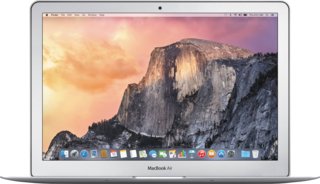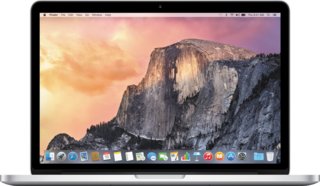Apple MacBook Air (2015) 13" vs Apple MacBook Pro (2015) 13"
Today, we're comparing two fan-favorite Apple laptops – the portable 2015 MacBook Air and the powerful 2015 MacBook Pro. We'll break down their designs, performances, and other must-know features in simple terms. Are you a creative professional seeking a performance powerhouse? Or maybe a student requiring a blend of portability and power? This guide is tailor-made for you! We'll highlight the pros and cons of each laptop, making sure every fact is spot on. Discover what sets these laptops apart in the tech market. Stick around for our final takeaway – a clear, practical piece of advice to simplify your laptop selection process!
System and application performance
Performance in popular 3D games
Viewing angle, color accuracy...
Ports, webcam and other interfaces
Potential battery life
Materials, durability and portability
Design Comparison
Size Comparison
When comparing the Apple MacBook Air (2015) 13" and the Apple MacBook Pro (2015) 13" regarding design elements that enhance user experience, we'll explore the key aspects influencing practical usability and aesthetic appeal for different user requirements.
Design Elements Comparison:
Ergonomics:
The laptops share a slim profile, measuring 0.7 inches in thickness, adding to their sleek and contemporary appearance.
- The MacBook Air weighs 3 pounds, making it a bit lighter than the 3.5-pound MacBook Pro, improving portability for users who are frequently on the move. The backlit keyboards on both models provide a convenient solution for working in dimly lit spaces.
- Both laptops feature a front camera for video calls and conferences, meeting the requirements of students and professionals.
Materials & Build Quality:
Both models feature Apple's iconic aluminum unibody design, delivering durability and a luxurious touch. The MacBook Pro offers more connectivity options than the MacBook Air with its HDMI output and Thunderbolt ports. The addition of Sleep and Charge USB ports on both laptops enhances practicality, allowing devices to charge while the laptop is in sleep mode.
Portability:
Both laptops are compact, offering high portability for users who prioritize mobility.
- The MacBook Air's lightweight design makes it ideal for students who require portability during their daily activities.
Aesthetic Appeal:
Both laptops feature Apple's distinctive design with sleek lines and minimalist aesthetics, catering to professionals in search of an elegant device.
- The MacBook Pro includes a VGA connector, which is useful for users needing to connect with older display devices.
User-Centric Considerations:
For Students:
The MacBook Air's lightweight design makes it a perfect companion for students transitioning between classes or study areas.
- The backlit keyboards on both models make late-night studying or working in dimly lit settings more convenient.
For Professionals:
The additional connectivity options on the MacBook Pro, such as Thunderbolt ports and HDMI outputs, cater to professional users requiring versatile connection capabilities. The sleek aluminum build common to both laptops exudes professionalism in any setting.
Conclusion:
In wrapping up, both the Apple MacBook Air (2015) 13" and Apple MacBook Pro (2015) 13" have several design features in common such as sleek designs, high-quality materials, and key characteristics like backlit keyboards. However, they vary when you look at ease of transport and connection possibilities. Students could find the MacBook Air more suitable due to its lighter weight, while working individuals might find the additional flexibility provided by the MacBook Pro's extra ports more beneficial.
Screen Comparison
| Apple MacBook Air (2015) 13" | Apple MacBook Pro (2015) 13" | |
|---|---|---|
| Resolution | HD | QHD |
| Screen Size | 13.3" | 13" |
Apple MacBook Air (2015) 13" versus Apple MacBook Pro (2015) 13": A Screen Comparison.
When deciding between the Apple MacBook Air (2015) 13" and the Apple MacBook Pro (2015) 13", it's crucial to assess their screen quality. Let's compare their screen size, resolution, pixel density, display technology, and how these aspects influence activities such as gaming or professional graphic design.
Screen Size:
- MacBook Air: The MacBook Air has a 13.3-inch screen.
- MacBook Pro: The MacBook Pro features a 13.3-inch screen.
Example Scenario:
The laptops' larger screens offer plenty of workspace for multitasking, allowing you to have multiple windows open at the same time while working on various projects.
Resolution & Pixel Density:
- MacBook Air: Provides a resolution of 1440 x 900 pixels and a pixel density of 127 ppi.
- MacBook Pro: Features a resolution of 2560 x 1440 pixels and a pixel density of 227 ppi.
Example Scenario: The MacBook Pro's higher resolution and pixel density deliver sharper images and text in comparison to the MacBook Air. This improved clarity offers benefits for tasks demanding precise visuals, like photo editing or video production.
Display Technology:
- The laptops both come equipped with IPS LCD screens featuring LED backlighting.
- The MacBook Pro features an anti-reflection coating that minimizes glare and enhances visibility in well-lit settings.
Example Scenario: The MacBook Pro's anti-reflection coating improves usability outdoors or in bright light, increasing comfort and reducing eye strain for extended work periods.
Supported Displays:
- Both laptops support up to three external displays for extended workspace capabilities.
Example Scenario: Professionals in graphic design can enhance their workflow by connecting multiple monitors, which enables them to expand their workspace for viewing reference material or tool palettes alongside their primary screen without causing clutter.
In conclusion, although both laptops have good screen quality, the MacBook Pro stands out with its superior visual clarity and versatility due to higher resolution, enhanced pixel density, and anti-reflection coating.
Hardware Comparison
| Apple MacBook Air (2015) 13" | Apple MacBook Pro (2015) 13" | |
|---|---|---|
| RAM | 8GB | 8GB |
| Storage Size | 512GB | 1000GB |
Comparing the hardware of the Apple MacBook Air (2015) 13" and Apple MacBook Pro (2015) 13", key components significantly impact performance and task suitability. Explore CPU, GPU, and RAM specs to make an informed choice.
Apple MacBook Air (2015) 13
- CPU: The MacBook Air is equipped with a 2 GHz dual-core Intel Core i7 processor that supports 4 threads.
- GPU: The integrated Intel HD Graphics 6000 offers reliable graphical performance for daily computing needs.
- RAM: The device is equipped with 8GB of LPDDR3 RAM running at 1600 MHz, ensuring seamless multitasking performance.
Performance Impact:
The dual-core processor handles tasks like web browsing, word processing, and multimedia use. The integrated GPU supports basic graphics but may not meet the demands of high-end applications or gaming. With 8GB RAM, multitasking is efficient, yet performance could be constrained with memory-intensive software.
Apple MacBook Pro (2015) 13
- CPU: The MacBook Pro features a 2 GHz dual-core Intel Core i7 processor with 4 threads.
- GPU: The Pro houses integrated Intel Iris Graphics that provide better graphical performance compared to the Air.
- RAM: It includes 8GB of LPDDR3 RAM clocked at 1866 MHz.
Performance Impact: The MacBook Pro's stronger GPU improves its performance in multimedia tasks, light gaming, and graphic design compared to the Air. Additionally, the faster RAM speed enhances overall system responsiveness and multitasking capabilities.
Comparison Summary:
- CPU & Threads: Both laptops share similar CPU configurations, suitable for everyday computing tasks.
- GPU Performance: The MacBook Pro's Iris Graphics offer better graphical performance compared to the Air's HD Graphics.
- RAM Speed: The Pro's faster RAM speed may result in slightly improved multitasking efficiency over the Air.
In conclusion, if you prioritize enhanced graphics performance for multimedia tasks or light gaming, the MacBook Pro might be a better choice due to its superior GPU capabilities. However, if you seek a more budget-friendly option for general productivity tasks without heavy graphic demands, the MacBook Air could still serve your needs effectively.
Battery Comparison
| Apple MacBook Air (2015) 13" | Apple MacBook Pro (2015) 13" | |
|---|---|---|
| Battery Life | 14 hours | 12 hours |
When comparing the battery performance of the Apple MacBook Air (2015) 13" and the Apple MacBook Pro (2015) 13", there are some key differences to consider:
Apple MacBook Air (2015) 13":
- Battery Life: Provides up to 14 hours of battery life on a single charge, catering to users who require a laptop that can sustain them throughout the day without constant recharging. Sleep And Charge USB Ports: This feature enables users to charge their devices while the MacBook is in sleep mode, enhancing convenience and versatility. MagSafe Power Adapter: Includes a MagSafe power adapter that provides a magnetic charging connection to minimize potential damage from accidental tugs or pulls.
Apple MacBook Pro (2015) 13":
- Battery Life: Offers up to 12 hours of usage on a single charge, slightly shorter than the MacBook Air. Though commendable, it lags behind the MacBook Air in terms of longevity.
- Sleep And Charge USB Ports: Like the MacBook Air, this model includes Sleep and Charge USB ports for easy charging while the laptop is in sleep mode.
- MagSafe Power Adapter: The MacBook Pro also comes with a MagSafe power adapter, ensuring secure and convenient charging.
In conclusion, although both laptops provide great battery life and convenient features like Sleep and Charge USB ports and MagSafe power adapters, the Apple MacBook Air (2015) 13" slightly outperforms the MacBook Pro with its longer 14-hour battery life. Those who value prolonged usage without frequent recharges may prefer the MacBook Air.
Verdict
Why Apple MacBook Air (2015) 13"?
- The MacBook Air (2015) 13" is lighter and more portable than the MacBook Pro (2015) 13", making it easier to carry around.
- It offers longer battery life, providing up to 14 hours of usage compared to the MacBook Pro's 12 hours.
- The MacBook Air is a more budget-friendly option while still catering to general productivity tasks effectively.
Why ?
- Superior GPU performance for multimedia tasks and light gaming.
- Faster RAM speed enhances system responsiveness and multitasking capabilities.
- Offers more connectivity options with HDMI output and Thunderbolt ports.
Similar comparisons
- Apple MacBook Air (2015) 13" vs Apple MacBook Air (2017) 13.3" Intel Core i5 128GB
- Apple MacBook (2016) vs Apple MacBook Air (2015) 13"
- Apple MacBook Air (2015) 11" vs Apple MacBook Pro (2015) 13"
- Apple MacBook (2016) vs Apple MacBook Pro (2015) 13"
- Apple MacBook (2016) vs Samsung Chromebook 4 Plus 15.6" Intel Celeron N4000

